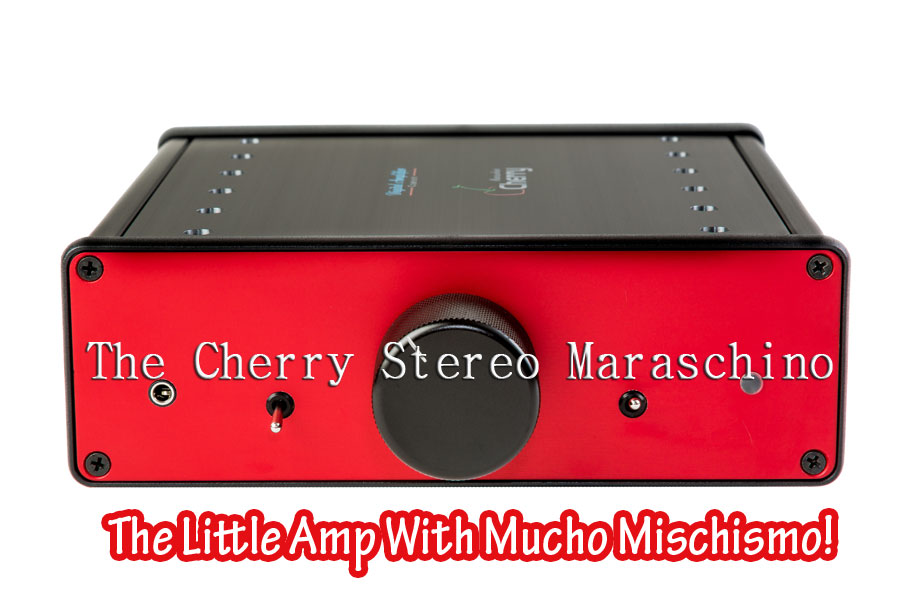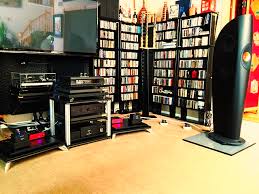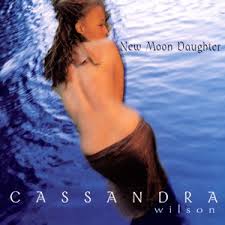Stereo Maraschino amplifier

 This past summer, a friend and accomplished jazz bassist, John Hébert, and I, paid a visit to the home of fellow audiophile John Jonczyk, who is also the proud owner of a new pair of Digital Amplifier Company (DAC) Golden Cherry Maraschino monoblock amplifiers. It was I however, who originally recommended John audition the Maraschino amps based on my experience with the bigger and beefier Cherry amplifiers (not to mention how excellent and affordable they are). Of course, after a short audition John informed me that he too was sold on the newest version of the Maraschino monoblocks. Upon our arrival one hot Saturday afternoon, John had the Maraschinos strapped to a pair of KEF Blade 2 loudspeakers with a modified Oppo tube CD player as the source. The sound was impressively rich in character and with a deep soundstage in this rather large dedicated listening space. However, for some strange reason, I felt the overall performance was better upon my last visit. I couldn’t be certain of it but had a sneaky suspicion that although the top end was very good; it was clean and the music had a respectable amount of air and shimmer. The midrange and lower bass however was less-defined and quick-footed as on my last visit. Moreover, John Hébert is an accomplished jazz bassist who felt something amiss in the low-end as well.
This past summer, a friend and accomplished jazz bassist, John Hébert, and I, paid a visit to the home of fellow audiophile John Jonczyk, who is also the proud owner of a new pair of Digital Amplifier Company (DAC) Golden Cherry Maraschino monoblock amplifiers. It was I however, who originally recommended John audition the Maraschino amps based on my experience with the bigger and beefier Cherry amplifiers (not to mention how excellent and affordable they are). Of course, after a short audition John informed me that he too was sold on the newest version of the Maraschino monoblocks. Upon our arrival one hot Saturday afternoon, John had the Maraschinos strapped to a pair of KEF Blade 2 loudspeakers with a modified Oppo tube CD player as the source. The sound was impressively rich in character and with a deep soundstage in this rather large dedicated listening space. However, for some strange reason, I felt the overall performance was better upon my last visit. I couldn’t be certain of it but had a sneaky suspicion that although the top end was very good; it was clean and the music had a respectable amount of air and shimmer. The midrange and lower bass however was less-defined and quick-footed as on my last visit. Moreover, John Hébert is an accomplished jazz bassist who felt something amiss in the low-end as well.
 Not certain who to blame: whether the Maraschino didn’t like the KEF Blades or vise versa (or was it the source or the cables). I started asking John some questions knowing he’s quite amendable and wouldn’t take my criticisms too personally. Turns out, he was trying out a new and more expensive set of AC cords than the Sound String SE series cables he had been using previously. In short, John simply changed out the AC cords (at the amplifiers and Oppo CD player) back to the Sound String SE and turned the system back on. In an instant, we were delighted as the excessive bass and bloat disappeared while the top-end shimmer and midrange remained excellent. I was relieved as I felt the KEF Blade’s side-firing woofers could have been creating havoc with the listening room. It was exciting to see a simple change in an AC cord could fix the bass problem. This seems impossible to anyone who doesn’t believe that cables can make a difference.
Not certain who to blame: whether the Maraschino didn’t like the KEF Blades or vise versa (or was it the source or the cables). I started asking John some questions knowing he’s quite amendable and wouldn’t take my criticisms too personally. Turns out, he was trying out a new and more expensive set of AC cords than the Sound String SE series cables he had been using previously. In short, John simply changed out the AC cords (at the amplifiers and Oppo CD player) back to the Sound String SE and turned the system back on. In an instant, we were delighted as the excessive bass and bloat disappeared while the top-end shimmer and midrange remained excellent. I was relieved as I felt the KEF Blade’s side-firing woofers could have been creating havoc with the listening room. It was exciting to see a simple change in an AC cord could fix the bass problem. This seems impossible to anyone who doesn’t believe that cables can make a difference.
A Knock at the Door?
 Well, guess who decided to drop by? DAC owner and designer Tommy O’Brien in the flesh. After introducing himself to John Hébert and myself, O’Brien sat in the sweet spot and became quite comfortable with the sound coming off these most attractive sounding KEF Blade 2’s. When I told him that the sound was markedly improved by the changing of a few AC cords, O’Brien laughed and said something like “I don’t believe that a cable can make that much of a difference!” Not surprised by this (I’ve encountered many designers who have come to the same conclusion), I just requested to John that we go back to previous AC cords, listen for a few songs, then switch them out once again. While in the middle of doing the swap, O’Brien went on with his professional prose on why a certain quality-made cable should perform the same as an expensive cable provided they’re made to same quality wire. Great theory on paper. Within five-minutes we were up and running and once again, through the Maraschino monoblocks the sound was almost too rich in the lower bass and midrange. Okay, O’Brien agreed that he may have heard more bass output via the cable swap but wasn’t absolutely certain. When switching back to the Sound String AC cords, the difference was so apparent and so obvious that Tommy O’Brien said “wow that is very improved bass indeed!” Yes, even a by-the-specs and talented amplifier designer now agrees that cables can make a difference and maybe he will tell his customers to choose their cables wisely.
Well, guess who decided to drop by? DAC owner and designer Tommy O’Brien in the flesh. After introducing himself to John Hébert and myself, O’Brien sat in the sweet spot and became quite comfortable with the sound coming off these most attractive sounding KEF Blade 2’s. When I told him that the sound was markedly improved by the changing of a few AC cords, O’Brien laughed and said something like “I don’t believe that a cable can make that much of a difference!” Not surprised by this (I’ve encountered many designers who have come to the same conclusion), I just requested to John that we go back to previous AC cords, listen for a few songs, then switch them out once again. While in the middle of doing the swap, O’Brien went on with his professional prose on why a certain quality-made cable should perform the same as an expensive cable provided they’re made to same quality wire. Great theory on paper. Within five-minutes we were up and running and once again, through the Maraschino monoblocks the sound was almost too rich in the lower bass and midrange. Okay, O’Brien agreed that he may have heard more bass output via the cable swap but wasn’t absolutely certain. When switching back to the Sound String AC cords, the difference was so apparent and so obvious that Tommy O’Brien said “wow that is very improved bass indeed!” Yes, even a by-the-specs and talented amplifier designer now agrees that cables can make a difference and maybe he will tell his customers to choose their cables wisely.
I only mention this particular visit because our next treat was to finally hear the new Stereo Maraschino amplifier – the subject of this review – and the reason for O’Brien’s visit. This standard model retails for only $1200.00 here in the USA. Surprisingly, even this standard 125 watt version performed surprisingly well on KEF Blade 2’s: detailed, quick and enriched with enough harmonic integrity to fool you into thinking it cost way more than its asking price.
Who and what is a Stereo Maraschino anyway?
Digital Amplifier Company (DAC) of Allentown PA, is a brand of digital amplification that I had become quite enamored with, beginning with their original big and beefy Cherry amplifier some years back. Tommy O’Brien, the company’s chief designer, and other digital amp designers like Bel Canto’s John Stronczer for example, are making great strides in the sound quality of digital amplification and couldn’t care less what some writers have claimed about how “inferior” digital amplifiers sound.
While Stronczer has introduced a new and far more expensive Bel Canto Black series, O’Brien has chosen to take a much more affordable approach with his Maraschino series of amplifiers. Being somewhat familiar with DAC, I think it would be safe to say the company has changed its products considerably in a span of 5 short years. The first thing I noticed in the new Stereo Maraschino amplifier – the very subject of this review – is how much of a physical transformation it has undergone. Chief designer, Tommy O’Brien, designed this newer series amplifier with the same patented and proprietary circuitry employed in his acclaimed Desktop and In-Line Maraschino monoblocks. The Stereo Maraschino however comes with its own volume control which precludes the need for a preamplifier.

 O’Brien boasts in one of his many emails that: “The case design was kept simple, and is the same size as our DAC DAC and 60V 1kW power supplies. This allows a ‘triple stack’ configuration: KING STM, DAC DAC, and 60V 1kW power supply. Sorbothane (TM) feet support the case to isolate external vibration. The standard STM model is $1200 list and includes a 48V power supply capable of 125Wpc into 4 or 8 Ohms. The KING version lists at $1700, and includes a 60V 1kW power supply capable of an authoritative 400Wpc into 4 Ohms. A modification for driving a DAC/DAC from the 60V power supply is also available, removing the need for a separate DAC/DAC power supply so you can power the entire system from a single AC outlet.”
O’Brien boasts in one of his many emails that: “The case design was kept simple, and is the same size as our DAC DAC and 60V 1kW power supplies. This allows a ‘triple stack’ configuration: KING STM, DAC DAC, and 60V 1kW power supply. Sorbothane (TM) feet support the case to isolate external vibration. The standard STM model is $1200 list and includes a 48V power supply capable of 125Wpc into 4 or 8 Ohms. The KING version lists at $1700, and includes a 60V 1kW power supply capable of an authoritative 400Wpc into 4 Ohms. A modification for driving a DAC/DAC from the 60V power supply is also available, removing the need for a separate DAC/DAC power supply so you can power the entire system from a single AC outlet.”
Physically owning a very small footprint and a cherry-red faceplate, the 125-watt Stereo Maraschino closer resembles a separate power supply rather than a conventional-sized amplifier boasting 125 watts per side. Unfortunately, due to its rather diminutive stature, super fat and exotic cables make for difficult connection on its rear. XLR connectors are standard but O’Brien provides XLR to RCA adapters free of charge. Truly built around affordability and portability, the Stereo Maraschino sound was designed to be “silky and fast” according to O’Brien, allowing for “accurate imaging and transient response.” Its low output impedance and DC coupling produce strong, tight bass down to 0 Hz for zero bass phase shift. The Stereo Maraschino has bandwidth reaching 100kHz, and an ultra-low noise floor and super-short signal path designed especially for hearing the lost information on familiar music tracks. There is a selectable auto-standby mode, so you can keep your Stereo Maraschino on at all times. The balanced input stages are designed to accommodate up to 6Vrms sources. The single-ended front input has a gain boost of 9.5dB for portable device compatibility. Input impedance is 40k balanced. Dual toggle switches, located on either side of the volume control knob, allow you to choose between 1/8 input jack (located on the front panel), MUTE (middle position) or the XLR input (located on the rear). The right toggle switch controls Power ON (up position), AUTO ON/OFF (middle position) and OFF (down position). Lastly, the units LED also located on the front panel will light RED (to indicate Standby mode), GREEN (running) and ORANGE (running at high voltage 60V).
In short, my time with the Stereo Maraschino since its arrival has been one of surprise and delight. For one, this standard model is the least expensive of the Stereo Maraschino models available which kept my sonic impressions very low. However, after installing this $1200 stereo amplifier in my office strapped to a pair of little KEF monitors, I got my biggest surprise when I placed it alongside my reference $40k, all tube, Russian-made G9 Audio mono amps and pre combo, driving a pair of Swiss-made Sound Kaos loudspeakers ($20k)! I knew that I put the Stereo Maraschino in way over its head.
Or did I?
 The Stereo Maraschino didn’t possess the glowing ambience, bloom or beauty of the G9’s glowing tube combo, but it did have a grasp on images that gave it superior image specificity. Cassandra Wilson’s Harvest Moon from her “New Moon Daughter,” remains on my short-list playlist after more than 15 years. The luscious guitar play, soulful jazz melody along with the melancholy styling Cassandra offers is hauntingly beautiful and instantly captivating. While the G9 offers up the emotions in way that can be memorable, the Stereo Maraschino didn’t embarrass itself either. In fact, it took the opening guitar strings and gave them energy and speed that proved on some level just as convincing – particularly if speed and dynamics is what strikes your fancy. I was expecting the stage as well as Cassandra’s voice to go flat and lay dead between the speakers. But the opposite occurred. The sound went into an entirely different direction where speed and clarity had priority over bloom and harmonic richness. Yet, Cassandra’s voice still had impact, weight and beauty. No, not to the same degree or realism of the all-tube G9 combo, but it was still believable nonetheless. And when you can get this level of believability at this asking price, then you’ve got something quite special in the Stereo Maraschino indeed.
The Stereo Maraschino didn’t possess the glowing ambience, bloom or beauty of the G9’s glowing tube combo, but it did have a grasp on images that gave it superior image specificity. Cassandra Wilson’s Harvest Moon from her “New Moon Daughter,” remains on my short-list playlist after more than 15 years. The luscious guitar play, soulful jazz melody along with the melancholy styling Cassandra offers is hauntingly beautiful and instantly captivating. While the G9 offers up the emotions in way that can be memorable, the Stereo Maraschino didn’t embarrass itself either. In fact, it took the opening guitar strings and gave them energy and speed that proved on some level just as convincing – particularly if speed and dynamics is what strikes your fancy. I was expecting the stage as well as Cassandra’s voice to go flat and lay dead between the speakers. But the opposite occurred. The sound went into an entirely different direction where speed and clarity had priority over bloom and harmonic richness. Yet, Cassandra’s voice still had impact, weight and beauty. No, not to the same degree or realism of the all-tube G9 combo, but it was still believable nonetheless. And when you can get this level of believability at this asking price, then you’ve got something quite special in the Stereo Maraschino indeed.
 Surprised? Absolutely. Upon first glance, it’s hard to think an amplifier this small and light can create this level of sonic excellence. That it can offer it up for a grand is also just as impressive. Time and again, everything song I put in front of the Stereo Maraschino, it performed wonderfully within its own boundaries. It’s not a bass demon or casts a soundstage that rivals my G9 tube amps. No, the Stereo Maraschino boasts an incredibly small signal path that translates into a more transparent window into the very fabric of each performance. The Stereo Maraschino also remains sonically true, thus engaging no matter how complex the material so listening fatigue is minimized. Physically small, it should disappear and have a high WAF (Wife Acceptance Factor), and yet can play loud enough (on moderately efficient loudspeakers) to raise the brow of big amp owners out there. All in all, I highly recommend a listen to this smartly designed amplifier. I think you might thank me. John Jonczyk certainly did!
Surprised? Absolutely. Upon first glance, it’s hard to think an amplifier this small and light can create this level of sonic excellence. That it can offer it up for a grand is also just as impressive. Time and again, everything song I put in front of the Stereo Maraschino, it performed wonderfully within its own boundaries. It’s not a bass demon or casts a soundstage that rivals my G9 tube amps. No, the Stereo Maraschino boasts an incredibly small signal path that translates into a more transparent window into the very fabric of each performance. The Stereo Maraschino also remains sonically true, thus engaging no matter how complex the material so listening fatigue is minimized. Physically small, it should disappear and have a high WAF (Wife Acceptance Factor), and yet can play loud enough (on moderately efficient loudspeakers) to raise the brow of big amp owners out there. All in all, I highly recommend a listen to this smartly designed amplifier. I think you might thank me. John Jonczyk certainly did! 

clement perry
Stereo Maraschino STM Specifications
Price: $1200.00 USA 48 Volt
$1700.00 USA 60 Volt (King Version)
Gain: 22dB
Sensitivity (KING 60V Version): 3.1Vin for 400W into 4Ω
Sensitivity (48V Version): 2.2Vin for 125W into 4Ω
SNR: 120dB
Input Impedance: 20 kΩ, true balanced
THD+N: 0.002%
Frequency Response: 0 Hz to >100 kHz
Size and Weight: 7.8″ x 6.5″ x 2.3″,
Output Power (KING 60V Version): 400Wpc into 4Ω
Output Power (48V Version): 125Wpc into 4Ω
Power Efficiency: 95%
Protection: Thermal, Current, Voltage, Auto-Recovery
Output Impedance:
AC Power (KING 60V Version): 100-130VAC/200-250VAC, 50-60Hz
AC Power (48V Version): 100-250VAC, 50-60Hz
Contact:
Email: support@digitalamp.com
Website: www.cherryamp.com
Stereo Times Masthead
Publisher/Founder
Clement Perry
Editor
Dave Thomas
Senior Editors
Frank Alles, Mike Girardi, Russell Lichter, Terry London, Moreno Mitchell, Paul Szabady, Bill Wells, Mike Wright, and Stephen Yan,
Current Contributors
David Abramson, Tim Barrall, Dave Allison, Ron Cook, Lewis Dardick, John Hoffman, Dan Secula, Don Shaulis, Greg Simmons, Eric Teh, Greg Voth, Richard Willie, Ed Van Winkle, Rob Dockery, Richard Doran, and Daveed Turek
Site Management Clement Perry
Ad Designer: Martin Perry





Be the first to comment on: Stereo Maraschino amplifier